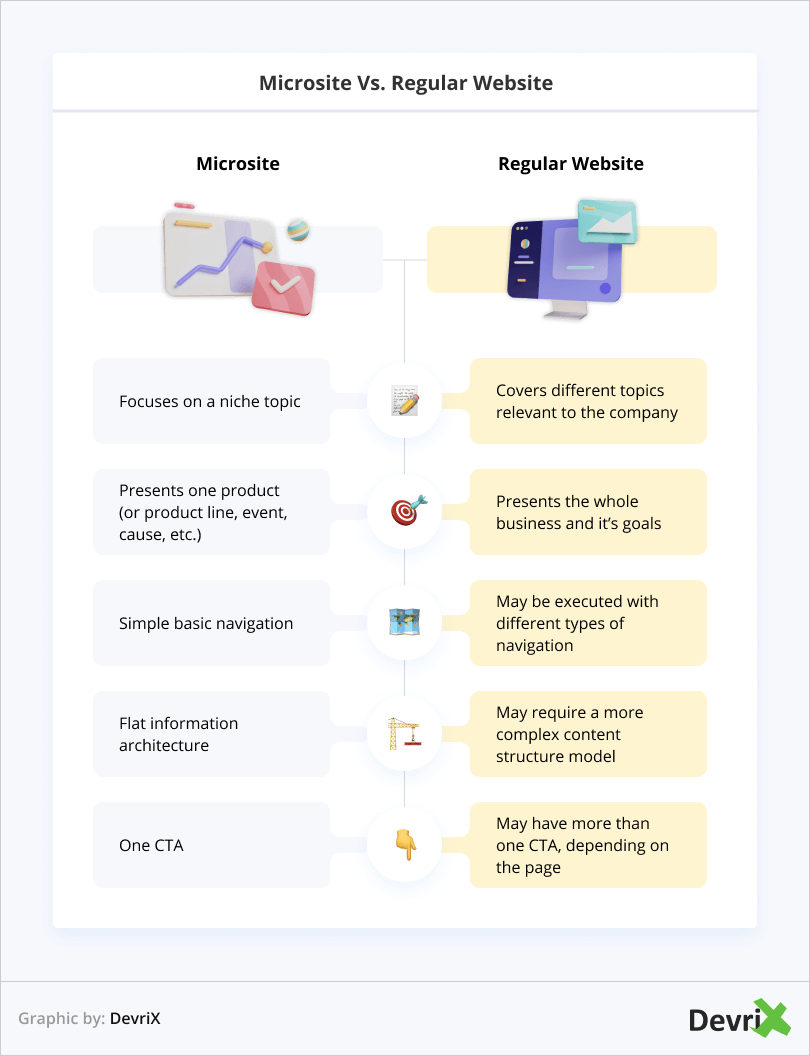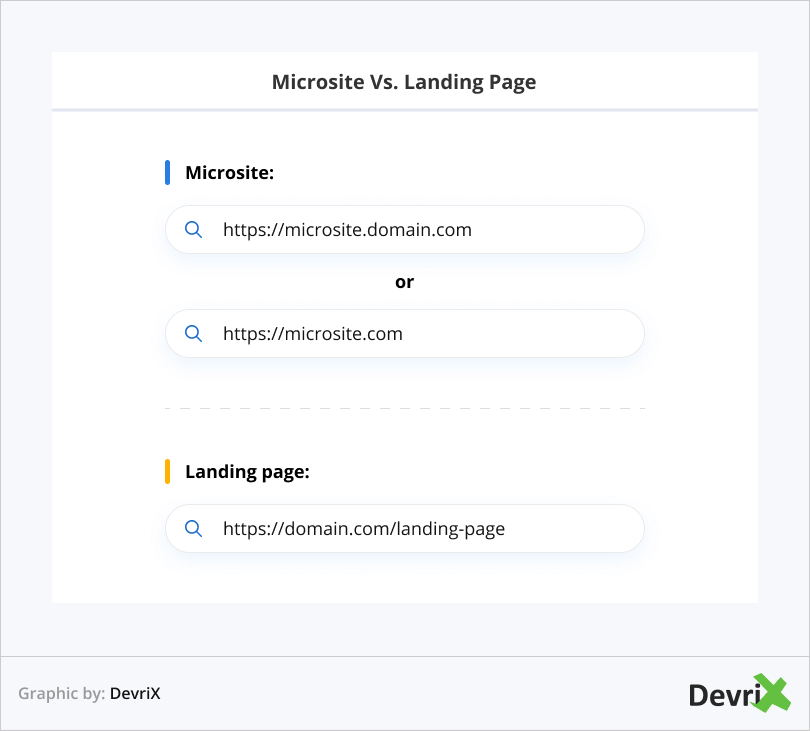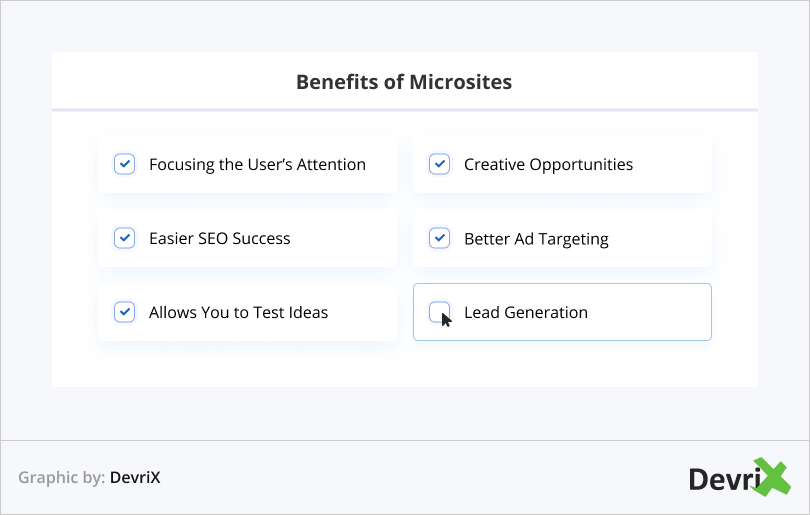Every day, there are new buzz-words in the digital world which hype up marketers with promises of exciting new ways to attract and engage their audiences. One of the trending terms that we’ve come across quite often lately is “microsite”. However, the internet being the way it is, there is a lot of misinformation on the topic.
As a development company, we decided to shed some light on what exactly a microsite is, how it is different from regular websites and landing pages, and how to leverage it in your online strategy.
In this article, we will provide information about the relevant definitions, explain the different types of microsites, list the benefits, and guide you with actionable ideas.
Read on to find out more!
What Is a Microsite?
A microsite is a branded page or a cluster of pages that occupies a stand-alone domain or, less often, a subdomain of the parent website. It is used to publish information that is somehow relevant to the company but is, at the same time, independent.
The main purpose of these types of websites is to differentiate the contents of the microsite from those of the main one and to focus the user’s attention on the topic in place. Depending on the site’s purpose, it can link to the parent domain and openly state the connection between the two, or the microsite can remain autonomous and anonymous.
For example, if you are launching a new line of products that are unique to your company and very different from what you’ve offered so far, you would want them to stand out and make an impression. If the customer has to browse through your whole website to find them, they may lose time, or not be able to find them. Furthermore, if you are launching a few different lines and want to feature them all on your homepage, it will become cluttered and messy.
By building stand-alone microsites to facilitate the promotion of each product line, you can use different designs and layouts that emphasize on and define their individual branding. In addition, this way, the product’s marketing message will not be diluted by your company’s overall approach.
How Is a Microsite Different from a Regular Website?

The microsite usually consists of a single page or a small number of pages the contents of which gravitate around a common topic. An exception of this rule are blog microsites that can have multiple pages and a bit wider variety of content. However, they still fit the description by focusing on a narrow niche, rather than a kaleidoscope of topics the way regular blogs do.
Another characteristic that separates microsites from other websites is that they usually lack the standard service pages such as About Us, Meet the Team, Products, Pricing, Shop, Contacts, FAQ, etc. Nevertheless, depending on the goals of the microsite, some of these may be present.
The simplicity of microsites also calls for basic navigation. More often than not, they are executed as a one-page solution where all the user needs to do to explore the content is to scroll down. If there are more than one pages, the information architecture is usually pretty flat, and all the pages are directly linked to the homepage.
How Is a Microsite Different from a Landing Page?
The main difference between a landing page and a microsite is that the landing page is located in the same domain as the main website, while the microsite has its own subdomain or a stand-alone address.

Landing page:
https://domain.com/landing-page
Microsite:
https://microsite.domain.com
or
Aside from that, the two entities can serve similar purposes. However, as mentioned, the microsite provides more opportunities to diversify the design, style, and content from the parent website.
Furthermore, as the domain name of the microsite can be keyword-focused, this allows for better SEO and easier ways to optimize PPC ads. In addition, you can use specific search terms in the URLs of the pages to improve your targeting and increase the visibility of the campaign or product.
As your main website is, presumably, already rich in content and keywords, the same results may be more difficult to accomplish there.
Types of Microsites
Depending on your needs, there are different types of microsites to consider. Generally, they fit into two categories – campaign oriented and ongoing.
Campaign oriented microsites have a limited lifespan and are created with the sole purpose to support a marketing or informational campaign. Once the promotion is over, the website is either removed, or not supported anymore.
Ongoing microsites are maintained and updated for an indefinite period of time. They are regularly populated with new content, or at least the information on them is kept fresh and relevant.
Benefits of Microsites

Here are some of the most prominent benefits of microsites:
- Focusing the User’s Attention. Microsites offer minimal distractions and allow users to concentrate on your campaign, product, and message. This increases the chances of achieving your goals.
- Creative Opportunities. You can design the new website anyway you want to without needing to refer to the parent domain and restrict to its style, colors, functionalities, ect. However, if you want to, you can still place easter eggs or align the design entirely to the original. The point is that you have a choice and creative freedom.
- Easier SEO Success. Microsites allow you to optimize for specific keywords, quickly gain awareness in the SERPs, and, on occasion, even build backlinks to your main website. However, keep in mind that creating microsites only for the sake of backlinks is not only inefficient, but is also considered a black hat tactic.
- Better Ad Targeting. Optimizing relevant PPC ads for microsites is easier because you are targeting a specific audience, using narrow-scope search terms, and may even have the keywords in your URLs.
- Allows You to Test Ideas. If you want to test a new product, content idea, or technology without risking potential failure to affect your brand and reputation, a microsite is a great way to do it.
- Lead Generation. Similarly to landing pages, microsites can be a powerful lead generation tool. As the website is on a specific topic, people that sign it and provide their information are more likely to really be interested in what you have to offer. Which means that with the proper content and CTAs, you can acquire high-quality sales-ready leads.
How to Leverage Microsites in Your Online Strategy
Here are some ways you can use a microsite:
Introducing New Products
One of the most common reasons to create a microsite is to dedicate it to a new product or service that you are launching.
The separate domain allows you to use the name of the product, making it shorter and easier to discover in direct search. Also, you can add relevant keywords that define the solution and contribute to your SEO efforts.
Furthermore, as mentioned, you can align the web design with the product’s properties and branding. By creating a unique and consistent experience, you increase the chances of boosting engagement.
The site can introduce the product’s features, clearly state its value proposition, feature whitepapers, PR information, resources, etc.
For example, American singer and songwriter Halsey launches a new microsite for each new album she creates in order to create their unique creative value:
Launching a Stand-Alone Blog
Although to many, blogging still sounds like a hobby for people with too much time on their hands, when it comes to business, a blog is a serious endeavor that takes a lot of planning, resources, and consistency.
If the company wants to position their blog as a stand alone digital publication, they can decide to launch it under a separate domain name and dedicate a sovereign editorial team to it.
There are many reasons to do this, including, but not limited to covering topics that are not entirely related to the company but important in the industry, SEO ranking and visibility, design and styling, differentiating the blog’s mission and attitude from the business’s, etc.
All in all, if the company wants to create an independent information outlet, a microsite is a viable option.
Providing Information About Events
Microsites are a great way to promote events without cluttering your website with excess information. This goes especially when the company has a rich calendar of events targeted at separate audiences.
You can use the site to provide details about the venue/s, sell tickets, introduce participants and sponsors, share schedules, post updates, create hype, and whatnot.
As events have limited lifespan, overtime, keeping this information on your main website may result in endless out-of-date pages that serve no purpose and drag down your overall ranking and domain authority.
Furthermore, with event promotion you usually need to obtain results in a timely manner. A stand-alone address will help you with boosting awareness and making the information more visible in organic search.
Supporting Promotional Campaigns
When it comes to promotional campaigns, microsites have similar purposes to landing pages – provide information in a compelling way and call to action.
However, the advantage of microsites is that they allow you to create a complete marketing experience. This way you can ensure better targeting, provide more distinct information, align the design with the campaign’s message and branding, and, ultimately, boost performance and results.
Creating a New Brand
Companies that have multiple brands under their umbrellas and want to differentiate them, can create microsites for each one. This way, they can develop the brand’s identity independently from their core business, create separate personas, and use appropriate targeting.
Each microsite can be designed with different pages and functionalities to serve the needs of the brand and its audience.
For example, if one of the brands is targeting senior citizens, the microsite can be executed in a simple and intuitive design, basic navigation, stripped down functions, and straight-forward messaging and CTAs. In addition, it can be supplied with a FAQ section to provide the users with quick and easy answers to their questions.
On the other hand, if another brand is focused on GenZs, the site can rely on more playful design, feature brighter colors, a gamified experience, pop-culture references, and more images.
Combining these two under a single domain can be confusing to both audiences, and, on top of that, it can make inbound marketing really challenging.
Popularize a Cause
Many companies support social and environmental causes and charities relevant to their brand’s values and ethics. While these may align with the company’s philosophy, depending on the company itself, it may be difficult to integrate them on the main website.
Dedicating a separate domain to the topic is a great way to emphasize on its meaningfulness and to increase impact.
The microsite can include the history of the cause, why the company holds it dear, relevant calculators, image galleries, videos, presentations, donation options, and whatever other information and resources are available.
For example, shoe brand El Naturalista has created a separate website where they cover the progress of the projects and causes they support, called We Believe in People.
Online Community
Companies that offer complex and innovative products and services, or have a large following of loyal customers, can greatly benefit from a dedicated forum. There, they can keep in touch with their clients, build a connection, help with answers to particular questions, and join discussions.
However, the nature of forums makes them difficult to integrate into the main content of the website. Depending on your goals, the best way to implement them is by using a subdomain or a separate microsite.
This will allow you to facilitate the community with the proper functions which allow users to easily interact.
Entertainment Hub
Aside from informational, educational, and business purposes, a microsite can be created for pure entertainment.
You can design a simple arcade game, a quiz, a trivia competition, or whatever rocks your boat. The only conditions are that it is somewhat relevant to your field and industry, and that your audience may find it interesting and engaging.
For example, Adobe’s Creative Types website does just that – it’s a fun personality test:

Bottom Line
While microsites are not something that your marketing strategy can’t go without, they hold great potential to segment and streamline your content management efforts.
You can use them to emphasize how a product or service differentiates from your main inventory, focus on individual brands, promote events, launch campaigns, and support any side activities and initiatives that you may want to experiment with.
While microsites have their limitations, they can be a great way to diversify your online presence and target different audiences without diluting your core messages.
If you need more information and assistance on how to build and design a microsite on WordPress, don’t hesitate to contact us!






